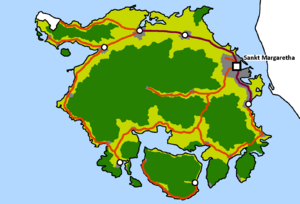Forum:Territory application/TA320 - Sankt Margaret
| Territory ID and proposed name | |
|---|---|
| The Territory ID (from OpenGeofiction:Territories, e.g. AR123a) and proposed name of the country |
TA320
English name: Saint Margaret
German name: Sankt Margaretha
Native name: Nianembiwi
| Physical geography | |
|---|---|
| An overview of climate, topography and landscape of the country. It is advised to also create a sketch, you can add a link to this (hosted on imgur or similar) |
Saint Margaret's geography will stay mostly the same, with tallest mountains (up to 2900m tall) located in the central/central-western part of the island. Around half of the population will live in the northern plains alongside an important route. Apart from the main island, there will be a smaller one, more active volcanically and much less densely populated. The island is rich in kaolin and bauxite.
 | Human geography |
|---|---|
| A brief description of the territory demographics, economic development, land occupation, infrastructure and mapping style |
The population of the island is around 2 million people, which gives ~400 inhabitants/km2. The capital city region will house around 600 thousand people
Saint Margaret is a developing nation, one of the poorer in the entire region sitting at around 6000$ GDP per capita. Most of the population works in agriculture, forestry, mining and porcelain manufacturing. The mapping style will resemble South American and Carribean nations/islands.
| History & culture | |
|---|---|
| A brief description of the intended culture and language |
The Saint Margaret Island was originally inhabited by the local Kabalya (possible name for the native people) people, who called the island “Nianembiwi” meaning “our land”.
The island was allegedly first spotted by an unnamed Franquese explorer in early 15th century. Since 1415, for a brief moment, the Franquese colonists established an outpost on the island, but the native inhabitants managed to get rid of them. Between 1423 and 1428 the island successfully managed to stay out of foreign hands. It is believed that on the 26th of October 1428, a Kalmish expedition arrived at the island. The newcomers managed to negotiate peace with the native population, a new city was to be established, but a quarter of produced and extracted resources were given to the natives. Since the date of the arrival was allegedly during the feast day of Saint Margaret of Rothenstadt, the island and the settlement were named Sankt Margaretha.
In 17 years since establishing the now capital city, Kalm managed to transfer enough army on the island to take it over. After a short lasting, eight months war, all native tribes surrendered to the colonizers. Kabalya people weren’t completely wiped off the island and instead they were forced to work for the colony, this saved the native Kabalya Nianembiwi language and culture from going extinct. The island had a strategic importance to Kalm, allowing it to monitor the western waters of Lycene region.
Sankt Margaretha has a rich history of porcelain production. The process of making porcelain dishes was known way before the colonists' arrival and has thrived through the Kalmish colonial rule. It is one of the main exports of the island alongside aluminium.
The island gained independence relatively recently, between 1920s and 1970s, and since then has been more or less successfully been a democracy. Kabalya Nianembiwi was made the second national language (alongside Kalmish) shortly after independence.
| Past mapping | |
|---|---|
| To support your request provide links to areas of OGF mapping which showcase your mapping skill. Mapping relevant to the requested theme & geography is especially useful | |
| The {{coord}} template can optionally be used to link to the OGF map - it results in a nice formatted link. Or you can paste in a URL. |
the country of Geklinia-Dregolesia (UL14b)
https://opengeofiction.net/#map=13/56.0490/74.7767&layers=B
https://opengeofiction.net/#map=14/57.7895/74.2066&layers=B
and other places
https://opengeofiction.net/#map=16/21.9916/4.0892&layers=B
https://opengeofiction.net/#map=14/30.0418/133.6628&layers=B
https://opengeofiction.net/#map=18/30.58333/133.88145&layers=B
https://opengeofiction.net/#map=15/31.9435/55.2973&layers=B
I was also the coordinator and long time active mapper of the now gone Ohesia project
| Username & date | |
|---|---|
| Sign and date the application by typing four tildes like this: ~~~~ |
Mie (talk) 23:11, 5 December 2023 (UTC)
 | Discussion |
|---|---|
| Discussion for clarification & decision |
- It's nice to see Kalmish influence returning to this region after many long years! I've had difficulty justifying my Kalmish populations in West Rabenthaler, Tigeria since the previous neighboring Kalmish-influenced territory stopped existing a few years ago. In my territories' history, I do have Meilanese trade routes between Tigeria and Inxigne so the Saint Margaret islands definitely existed on their sea charts as early as the 1400s and was known to the Franquese empire by the 1500s. Chazeltine (talk) 03:35, 7 December 2023 (UTC)
 |
Territory application approved |
|---|---|
| Thank you for your patience. I reckon there's some shared history we, as mappers, should discuss, but that should happen outside this page. Taka (talk) 13:28, 3 April 2024 (UTC) | |
| As you develop your territory, be sure to keep it realistic. Here are some resources you may find useful for starting out: Help:Portal, Help:Making realistic countries, Help:Making realistic cities and OpenGeofiction:Site policies |
